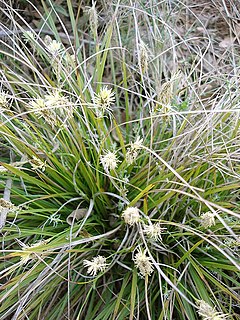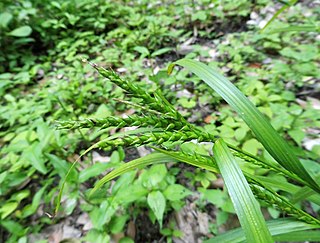
The Cyperaceae are a family of graminoid (grass-like), monocotyledonous flowering plants known as sedges. The family is large, with some 5,500 known species described in about 90 genera, the largest being the "true sedges" genus Carex with over 2,000 species.

Vigna is a genus of flowering plants in the legume family, Fabaceae, with a pantropical distribution. It includes some well-known cultivated species, including many types of beans. Some are former members of the genus Phaseolus. According to Hortus Third, Vigna differs from Phaseolus in biochemistry and pollen structure, and in details of the style and stipules.

Agropyron is a genus of Eurasian plants in the grass family), native to Europe and Asia but widely naturalized in North America.

Carex is a vast genus of more than 2,000 species of grass-like plants in the family Cyperaceae, commonly known as sedges. Other members of the family Cyperaceae are also called sedges, however those of genus Carex may be called true sedges, and it is the most species-rich genus in the family. The study of Carex is known as caricology.
Jisaburo Ohwi was Japanese botanist. He was a distinguished member of the Faculty of Science of Kyoto Imperial University. He is perhaps best known for his 1953 Flora of Japan.
Carex accrescens is a species of sedge that was first described by Jisaburo Ohwi in 1931. It is native to eastern Asia, from Siberia to the Korean Peninsula and Japan.
Carex atroviridis is a species of flowering plant in the family Cyperaceae. It was first formally named in 1931 by Jisaburo Ohwi. Carex atroviridis is endemic to Japan.
Carex autumnalis is a species of flowering plant in the sedge family, Cyperaceae. It was first formally named by Jisaburo Ohwi in 1930. Carex autumnalis is native to Japan and mainland eastern Asia, from southeastern China to North Korea. In China it grows in shady ravines.

Carex lanceolata is a species of sedge, native to the eastern half of China, Mongolia, eastern Siberia, Korea, Sakhalin, and Japan. Its seeds are dispersed by ants.
Iris formosana is a plant species in the genus Iris, it is also in the subgenus Limniris and the section Lophiris. It is a rhizomatous perennial plant, from Taiwan, it has large white or lilac flowers. It is commonly known as the 'Taiwan iris'. It is cultivated as an ornamental plant in temperate regions.

Carex kobomugi is a species of sedge, known as the Japanese sedge or Asiatic sand sedge, that lives in sandy coastal areas of eastern Asia, and has become an invasive species in the north-eastern United States.

Carex ischnostachya is an herbaceous graminoid plant in the sedge family (Cyperaceae). It is native to the eastern Asia, where it is found in China, Japan, and Korea. Its natural habitat is in forest openings in wet areas, in hills or mountains. It is a common species, and is often found along roadsides or trails.
Carex haematorrhyncha is a species of plant in the family Cyperaceae first described by Jisaburo Ohwi and Tetsuo Michael Koyama. No subspecies are listed in the Catalogue of Life.
Carex aphyllopus is a species of sedge. Its native range is Central Japan.
Carex geantha is a species of sedge and is native to Japan.
Carex yamatsutana is a species of sedge. It is native to the regions of Amur, Khabarovsk Krai, Primorsky Krai, and Yakutsiya in Russia, and also Inner Mongolia in China, and Mongolia.
Carex × kurilensis is a species of sedge.
Carex × musashiensis is a species of sedge.
Carex × sakaguchii is a species of sedge and is native to Japan.






